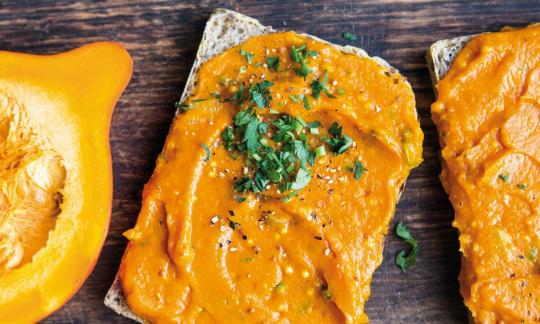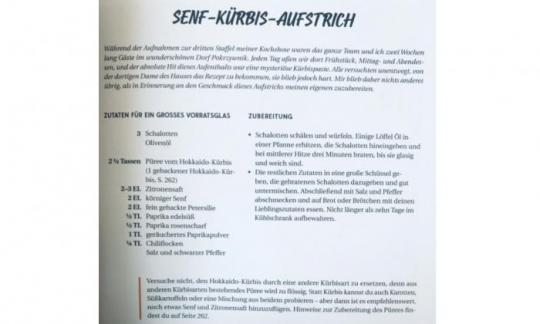Mustard-pumpkin spread with parsley and paprika spice
vegan
Ingredients (for servings, )
| For the pumpkin puree | |
|---|---|
| 1 kg | Hokkaido pumpkins (Hokkaido pumpkins) (35 oz) |
| For the spread | |
| 3 | Shallots, raw (organic?) (2.1 oz) |
| 1 tbsp | Rapeseed oil, refined (organic?) (0.49 oz) |
| 2 ½ tbsp | Lemon juice (raw?, organic?) (0.64 oz) |
| 2 tbsp | Mustard (Mostert, Mostrich, raw?, organic?) (0.88 oz) |
| 2 tbsp | Parsley, fresh, raw (leaf parsley, parsley) (0.27 oz) |
| ½ tsp | Paprika powder, sweet (raw?, organic?) (0.04 oz) |
| ½ tsp | Paprika powder, hot (raw?, organic?) (0.04 oz) |
| 1 tsp | Pimentón de la Vera (smoked paprika powder, organic?) (0.08 oz) |
| ¼ tsp | Chili flakes (raw?, organic?) (0.04 oz) |
| 1 dash | Table salt (table salt, raw?, organic?) (0.01 oz) |
| 1 dash | Black pepper (organic?, raw?) (0.00 oz) |
Equipment
- hand-held blender / immersion blender or blender
- skillet (frying pan)
- stove
- citrus juicer (lemon squeezer)
- oven
Type of preparation
- bake
- chop or grind
- sauté
- squeeze
- season to taste
- purée
- remove the skin
Preparation
For the pumpkin puree
Preheat the oven to 200 °C, halve or quarter the washed Hokkaido pumpkin and put it in the hot oven. Bake for about an hour until soft, then remove the seeds with a spoon, scrape out the flesh and puree.For the spread
Peel and dice the shallots. Heat the rapeseed oil in a pan, add the shallots and sauté over medium heat for three minutes until they are translucent and soft.The author uses a few tablespoons of olive oil. Instead, we use 1 tablespoon of refined rapeseed oil for 10 servings (see tips).
Put the pumpkin puree from step 1 into a bowl together with the shallots. Add freshly squeezed lemon juice and finely chopped parsley as well as the remaining spices and mix well. Then season with salt and pepper.
The author recommends using grainy mustard. In addition to ½ teaspoon of sweet paprika powder, she uses ½ teaspoon of hot paprika powder and 1 teaspoon of smoked paprika powder for 10 portions.
Serve
Eat the mustard pumpkin spread on bread or rolls with your favorite ingredients.Do not store in the refrigerator for longer than ten days.
|
Nutritional Information per person
Convert per 100g
|
2000 kcal | |
|---|---|---|
| Energy | 55 kcal | 2.7% |
| Fat/Lipids | 1.7 g | 2.4% |
| Saturated Fats | 0.15 g | 0.8% |
| Carbohydrates (inc.dietary fiber) | 10 g | 3.8% |
| Sugars | 2.9 g | 3.2% |
| Fiber | 2.0 g | 7.9% |
| Protein/Albumin | 1.3 g | 2.6% |
| Cooking Salt (Na:48.6 mg) | 123 mg | 5.1% |
| Essential micronutrients with the highest proportions | per person | 2000 kcal | |
|---|---|---|---|
| Vit | Vitamin A, as RAE | 169 µg | 21.0% |
| Elem | Potassium, K | 387 mg | 19.0% |
| Vit | Vitamin C (ascorbic acid) | 15 mg | 18.0% |
| Vit | Folate, as the active form of folic acid (née vitamin B9 and | 28 µg | 14.0% |
| Vit | Vitamin B6 (pyridoxine) | 0.18 mg | 13.0% |
| Min | Manganese, Mn | 0.20 mg | 10.0% |
| Prot | Tryptophan (Trp, W) | 0.02 g | 10.0% |
| Min | Copper, Cu | 0.08 mg | 8.0% |
| Fat | Alpha-Linolenic acid; ALA; 18:3 omega-3 | 0.15 g | 7.0% |
| Min | Iron, Fe | 0.80 mg | 6.0% |
Detailed Nutritional Information per Person for this Recipe
The majority of the nutritional information comes from the USDA (US Department of Agriculture). This means that the information for natural products is often incomplete or only given within broader categories, whereas in most cases products made from these have more complete information displayed.
If we take flaxseed, for example, the important essential amino acid ALA (omega-3) is only included in an overarching category whereas for flaxseed oil ALA is listed specifically. In time, we will be able to change this, but it will require a lot of work. An “i” appears behind ingredients that have been adjusted and an explanation appears when you hover over this symbol.
For Erb Muesli, the original calculations resulted in 48 % of the daily requirement of ALA — but with the correction, we see that the muesli actually covers >100 % of the necessary recommendation for the omega-3 fatty acid ALA. Our goal is to eventually be able to compare the nutritional value of our recipes with those that are used in conventional western lifestyles.
| Essential fatty acids | per person | 2000 kcal |
|---|---|---|
| Alpha-Linolenic acid; ALA; 18:3 omega-3 | 0.15 g | 7.0% |
| Linoleic acid; LA; 18:2 omega-6 | 0.32 g | 3.0% |
| Essential amino acids | per person | 2000 kcal |
|---|---|---|
| Tryptophan (Trp, W) | 0.02 g | 10.0% |
| Threonine (Thr, T) | 0.06 g | 6.0% |
| Isoleucine (Ile, I) | 0.07 g | 6.0% |
| Valine (Val, V) | 0.08 g | 5.0% |
| Leucine (Leu, L) | 0.10 g | 4.0% |
| Lysine (Lys, K) | 0.07 g | 4.0% |
| Phenylalanine (Phe, F) | 0.07 g | 4.0% |
| Methionine (Met, M) | 0.02 g | 2.0% |
| Vitamins | per person | 2000 kcal |
|---|---|---|
| Vitamin A, as RAE | 169 µg | 21.0% |
| Vitamin C (ascorbic acid) | 15 mg | 18.0% |
| Folate, as the active form of folic acid (née vitamin B9 and | 28 µg | 14.0% |
| Vitamin B6 (pyridoxine) | 0.18 mg | 13.0% |
| Vitamin K | 4.9 µg | 6.0% |
| Riboflavin (vitamin B2) | 0.07 mg | 5.0% |
| Thiamine (vitamin B1) | 0.04 mg | 4.0% |
| Niacin (née vitamin B3) | 0.58 mg | 4.0% |
| Pantothenic acid (vitamin B5) | 0.22 mg | 4.0% |
| Vitamin E, as a-TEs | 0.18 mg | 1.0% |
| Essential macroelements (macronutrients) | per person | 2000 kcal |
|---|---|---|
| Potassium, K | 387 mg | 19.0% |
| Sodium, Na | 49 mg | 6.0% |
| Magnesium, Mg | 17 mg | 5.0% |
| Calcium, Ca | 34 mg | 4.0% |
| Phosphorus, P | 31 mg | 4.0% |
| Essential trace elements (micronutrients) | per person | 2000 kcal |
|---|---|---|
| Manganese, Mn | 0.20 mg | 10.0% |
| Copper, Cu | 0.08 mg | 8.0% |
| Iron, Fe | 0.80 mg | 6.0% |
| Zinc, Zn | 0.27 mg | 3.0% |
| Selenium, Se | 1.3 µg | 2.0% |
| Fluorine, F | 0.50 µg | < 0.1% |
| Iod, I (Jod, J) | 0.02 µg | < 0.1% |
The mustard-pumpkin spread with parsley and paprika spice is suitable both as a spread and as a dip.
Serving size: The indicated amount for 10 servings makes a large storage jar. However, this should not be kept in the refrigerator for longer than ten days.
Nutrient profile: The ratio of omega-6 to omega-3 fatty acids is 2:1, well below the recommended maximum ratio of 5:1 - but contains only small amounts per serving. The mustard pumpkin spread is also rich in potassium.
Hokkaido pumpkin: Unlike most other pumpkins, the skin of the small Hokkaido pumpkin, which weighs only 1-2 kg, is eaten as it becomes soft when cooked. The flesh is low in fibre and has a slightly nutty flavour. It owes its orange colour to the high levels of beta-carotene it contains, which our body can convert into vitamin A. It also contains large amounts of vitamins B1, B2 and B6, vitamin C and vitamin E as well as folic acid, magnesium, iron and phosphorus.
Paprika powder: The ingredient responsible for the spiciness is the alkaloid capsaicin. In peppers, it is mainly found in the placental wall and the septa, which makes them significantly hotter than the actual flesh. Paprika powder is available in various degrees of spiciness and flavors. The main varieties available are sweet paprika powder (mild and spicy) and rose paprika (hot). Depending on the country, other degrees of spiciness or flavors are also available, such as the smoked paprika powder used in this recipe.
Olive oil versus rapeseed oil: Economic forces and lobbying have made olive oil a cult oil, although the omega-6 (LA) to omega-3 fatty acid (ALA) ratio is significantly higher than the recommended maximum ratio of 5:1. Compared to olive oil, rapeseed oil has several times the proportion of essential fatty acids, especially omega-3 fatty acids. Cold-pressed rapeseed oil is not suitable in this case, as cold-pressed oils can only be heated slightly, in the case of cold-pressed rapeseed oil up to a maximum of 120 °C, otherwise harmful substances are created. See the following link ( cold-pressed rapeseed oil). But even refined rapeseed oil should only be heated to a maximum of 180 °C.
Information and advice on common nutritional errors made by vegans and raw foodists can be found at the following link:
Vegans often eat unhealthily. Avoidable nutritional errors.
Marta Dymek: Do not try to replace the Hokkaido pumpkin with any other type of pumpkin, because puree made from other types of pumpkin will be too runny. Instead of pumpkin, you can also try carrots, sweet potatoes or a mixture of both - but then it is recommended to add some mustard and lemon juice.





